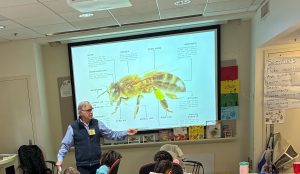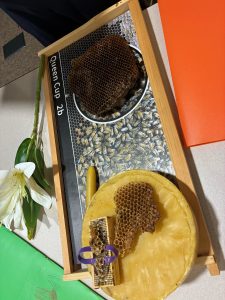Saturday SAVY, Day 2 – “Plants and Pollen” (1st/2nd)
We learned a lot about pollinators today. Students learned about the anatomy and life cycles of bees. We also identified the metamorphosis of butterflies and ladybugs.
We had a demonstration by a beekeeper from the Beekeepers Association of Tennessee. Students handled beeswax, honeycomb, and even had a chance to try on beekeepers’ outfits. Mr. Foy, the beekeeper, taught a lot about the importance of bees and how they not only impact our gardens, but also crops through pollination.
We discussed how different flowers are pollinated in different ways. We reviewed our knowledge from last week on flowers, identifying the stigma and pollen sources, as well as how different flowers attract their pollinators with their color and scent.
We performed a read-through of a script about an apple orchard through the four seasons and how Integrated Pest Management could be used instead of pesticides at the orchard. We discussed the problems caused by the fruit tree leaf roller, weevils, and apple moth larvae, and the solutions offered in each case by the introduction of lady beetle larvae, glue on tree trunks, and the scent of adult moths. We also reflected on whether insects can be both problems and solutions.
Our studies then led to discussions on how pollination leads to seeds, which then produce new plants. Students took white beans home to observe. Hopefully, germination will start in a week for us to discuss their seedlings next week.
I am excited for our final Saturday together next week, when students will use their knowledge gained from our time together to design and build hand pollinators for a variety of plants.
Questions to ask your Agricultural Engineer about today:
- What are the three body parts of insects? (They might sing you their song about the head, thorax, abdomen)
- Why do you think bees need antennae? (For touch and smell).
- What do bees and butterflies use to suck nectar? (proboscis)
- To which body section do the legs connect? (thorax)
- Where are the wings attached? (thorax)
- What does metamorphosis mean?
- How can we help bees? (planting gardens and avoiding pesticides that harm them)
- What are some natural ways to solve problems posed by invasive insects? (Integrated Pest Management – insect control that relies on natural systems, like introducing lady beetle larvae)
- How are flowers pollinated, and how does the shape, color, and scent of the flower impact how pollination is achieved?



